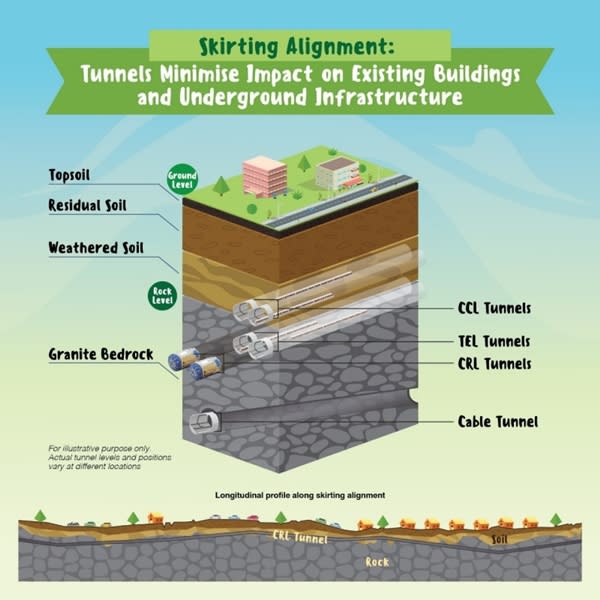CRL to run directly beneath Central Catchment Nature Reserve: MOT
The government said the direct route will be more environment-friendly in the long run because it “has lower energy consumption”.
After years of debate, discussion and consultation, the Ministry of Transport (MOT) has decided to build the Cross Island MRT Line (CRL) under the Central Catchment Nature Reserve, instead of going around it.
According to the ministry, the direct alignment will have tunnels that go 70m – about the height of a 25-storey HDB block – below the Central Catchment Nature Reserve, reported The Straits Times.
Announcing the decision on Wednesday (Dec 4), MOT said the direct alignment will see travel time cut by six minutes compared to the skirting around option. As a result, the average fares will also be 15% cheaper as the route is shorter and more direct. Furthermore, construction costs will also be $2 billion lower.
Photo: LTA
This CRL will be 50km long and will run across from Changi to Jurong, serving estates such as Ang Mo Kio, Clementi and Pasir Ris. It is estimated that the line will carry 600,000 passengers per day upon its completion in 2031.
While the option of skirting around and going directly under the reserve area were both considered viable after an extensive study, nature groups had strongly implored the government to consider the skirting around option to avoid any negative impact on flora and fauna in the gazetted reserve close to the MacRitchie Reservoir.
RELATED: Are Property Owners Near The Cross Island Line Sitting On A Goldmine?
Ministry: Direct route will save taxpayers’ money
The ministry, however, believes that the direct route will be more environment-friendly in the long run because it “has lower energy consumption”.
In a statement, the MOT outlined measures, based on feedback from nature groups, which will mitigate the line’s environmental impact.
Digging as deep as 70m below the reserve will ensure that the work is done through granite, far below from surface flora and fauna. The ministry added that no surface works will be done in the reserve, explaining that MRT tunnels are typically 20m to 30m underground.
Transport Minister Khaw Boon Wan said the government has had a tough time over the alignment because the reserve is considered “a special part of Singapore”, adding that going around the reserve would “cost taxpayers and commuters dearly”.
“The environment assessment has shown that both alignments are feasible. Also, the skirting option would result in longer travel time, additional construction as well as expected higher commuter fares,” said Senior Minister of State for Transport Lam Pin Min.
“We have therefore decided on the direct alignment.”
MOT said that different factors had been considered before the direct alignment was chosen, including the findings resulting from the two-phase environmental study.
The first phase looked at the effect of soil works on the flora and fauna of the reserve, and determined that initial tests could have a “moderate” impact on wildlife if reduction measures were done.
The second phase then looked at the effect of the operation and construction of the line, and also concluded that this impact could be reduced if measures for mitigation were carried out.
Looking for a property in Singapore? Visit PropertyGuru’s Listings, Project Reviews and Guides.
Victor Kang, Digital Content Specialist at PropertyGuru, edited this story. To contact him about this or other stories, email victorkang@propertyguru.com.sg

 Yahoo Finance
Yahoo Finance 

